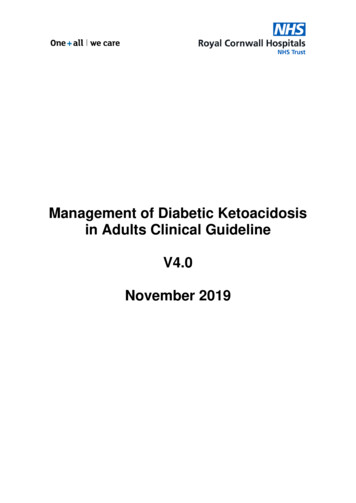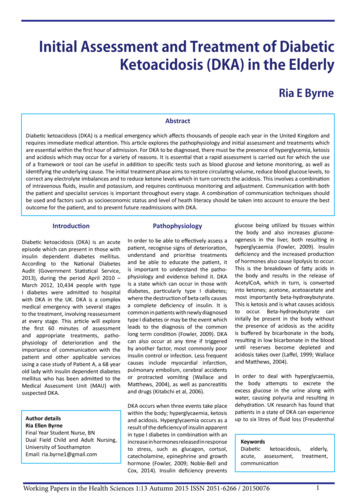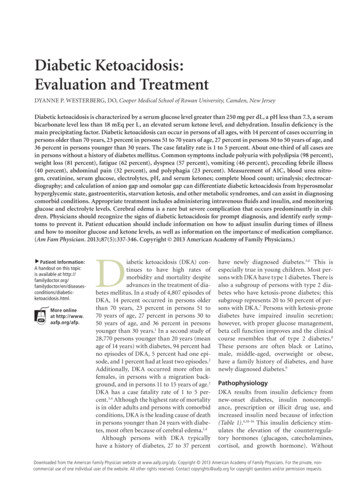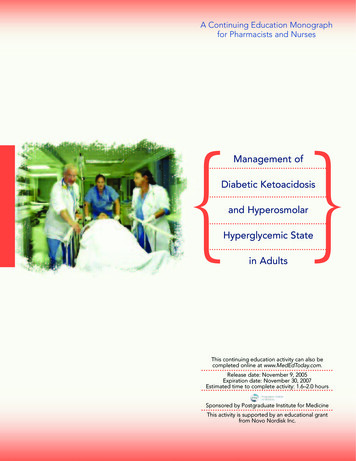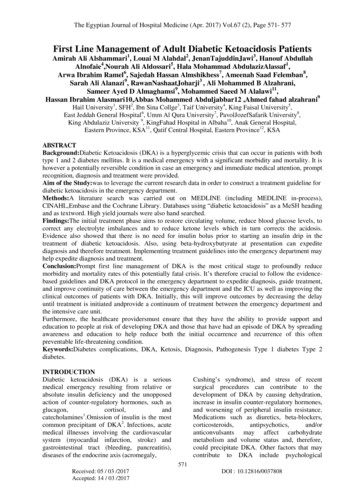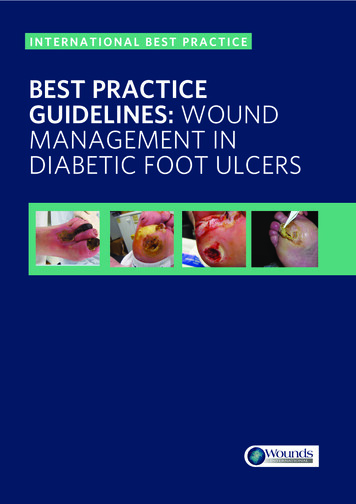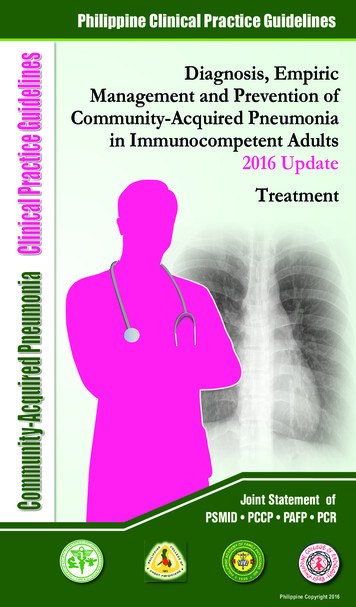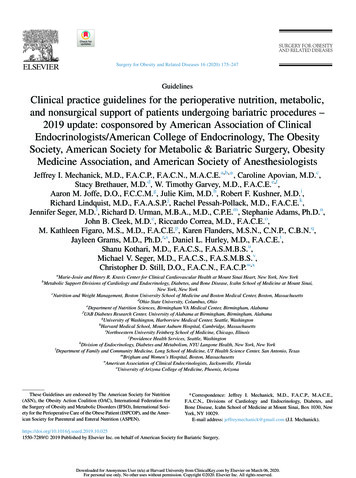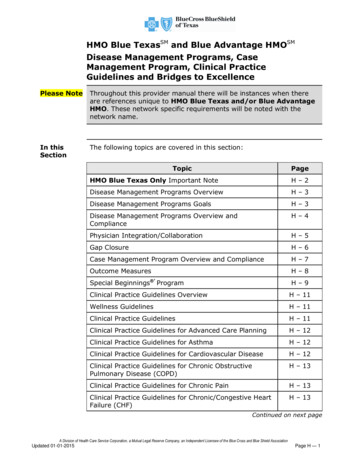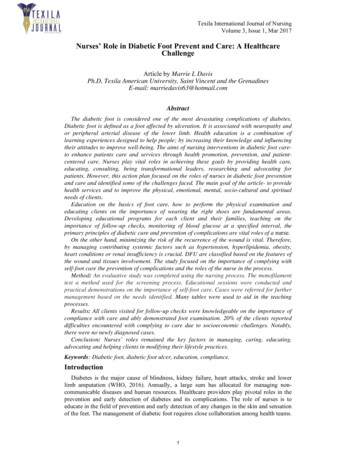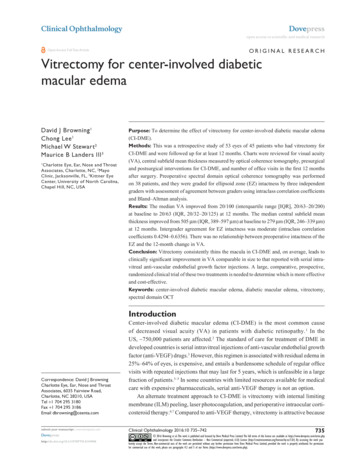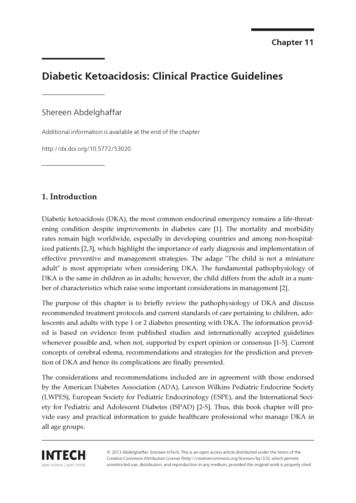
Transcription
Chapter 11Diabetic Ketoacidosis: Clinical Practice GuidelinesShereen AbdelghaffarAdditional information is available at the end of the chapterhttp://dx.doi.org/10.5772/530201. IntroductionDiabetic ketoacidosis (DKA), the most common endocrinal emergency remains a life-threat‐ening condition despite improvements in diabetes care [1]. The mortality and morbidityrates remain high worldwide, especially in developing countries and among non-hospital‐ized patients [2,3], which highlight the importance of early diagnosis and implementation ofeffective preventive and management strategies. The adage "The child is not a miniatureadult" is most appropriate when considering DKA. The fundamental pathophysiology ofDKA is the same in children as in adults; however, the child differs from the adult in a num‐ber of characteristics which raise some important considerations in management [2].The purpose of this chapter is to briefly review the pathophysiology of DKA and discussrecommended treatment protocols and current standards of care pertaining to children, ado‐lescents and adults with type 1 or 2 diabetes presenting with DKA. The information provid‐ed is based on evidence from published studies and internationally accepted guidelineswhenever possible and, when not, supported by expert opinion or consensus [1-5]. Currentconcepts of cerebral edema, recommendations and strategies for the prediction and preven‐tion of DKA and hence its complications are finally presented.The considerations and recommendations included are in agreement with those endorsedby the American Diabetes Association (ADA), Lawson Wilkins Pediatric Endocrine Society(LWPES), European Society for Pediatric Endocrinology (ESPE), and the International Soci‐ety for Pediatric and Adolescent Diabetes (ISPAD) [2-5]. Thus, this book chapter will pro‐vide easy and practical information to guide healthcare professional who manage DKA inall age groups. 2013 Abdelghaffar; licensee InTech. This is an open access article distributed under the terms of theCreative Commons Attribution License (http://creativecommons.org/licenses/by/3.0), which permitsunrestricted use, distribution, and reproduction in any medium, provided the original work is properly cited.
294Type 1 Diabetes2. Definition of Diabetic Ketoacidosis (DKA)The biochemical criteria for DKA include the following triad [4]: Hyperglycemia (blood glucose 11 mmol/L [200 mg/dL]) Venous pH 7.3 and/or bicarbonate 15 mmol/L Ketonemia and ketonuria3. Pathophysiology of DKADiabetic ketoacidosis (DKA) results from absolute or relative deficiency of circulating insu‐lin and the combined effects of increased levels of the counterregulatory hormones: cate‐cholamines, glucagon, cortisol and growth hormone [5].Absolute insulin deficiency occurs in the following conditions: undiagnosed type 1 diabetes mellitus (T1DM); DKA is reported be the first presentationin about 25% of cases especially in those less than 5 years old [ 2 ]. patients on treatment who miss their insulin doses, especially the long-acting componentof a basal-bolus regimen. It is estimated that 75% of DKA episodes are associated with in‐sulin omission or treatment error [6]. patients who use insulin pump if insulin delivery fails [7].Relative insulin deficiency, on the other hand, occurs when the concentrations of counterregu‐latory hormones increase in response to stress in conditions such as: sepsis, trauma, or gastrointestinal illness with diarrhea and vomiting.The combination of low serum insulin and high counterregulatory hormone concentrationsresults in an accelerated catabolic state with increased glucose production by the liver andkidney (via glycogenolysis and gluconeogenesis), impaired peripheral glucose utilization re‐sulting in hyperglycemia and hyperosmolality, and increased lipolysis and ketogenesis,causing ketonemia and metabolic acidosis [4].Hyperglycemia and hyperketonemia cause osmotic diuresis, dehydration, and electrolyteloss. This stimulates stress hormone production, which induces insulin resistance and leadsto a vicious circle, worsening the hyperglycemia and hyperketonemia. Fatal dehydrationand metabolic acidosis will ensue if management is not initiated. Poor tissue perfusion orsepsis may lead to lactic acidosis which can aggravate the ketoacidosis [5].
Diabetic Ketoacidosis: Clinical Practice Guidelineshttp://dx.doi.org/10.5772/53020At presentation, the magnitude of specific deficits of fluid and electrolytes in an individualpatient varies depending upon the extent to which the patient was able to maintain intake offluid and electrolytes, and the content of food and fluids consumed before coming to medi‐cal attention and the duration and severity of illness [8].4. Epidemiology of DKAThere is wide geographic variation in the frequency of DKA at onset of diabetes; rates inver‐sely correlate with the regional incidence of type 1 diabetes. Frequencies range from 15 to70% in different regions of the world [9 -14].4.1. Frequency of DKAAt disease onsetDKA at diagnosis of type 1 diabetes occurs more commonly in [15,16]: children younger than four years of age children with absent first-degree relative with T1DM and families of a lower socioeconomic classType 2 diabetes mellitus (T2DM), associated with increased rates and severity of obesity,may account for as much as one half of newly diagnosed diabetes in those aged 10 to 21years, depending on the socioeconomic and ethnic composition of the population [2]. Acutedecompensation with DKA has been recognized to occur at the time of diagnosis in as manyas 25% of children with type 2Diabetes Mellitus (T2DM0 [17].In children with established diabetes (recurrent DKA)[4]The risk of DKA in established T1DM is 1–10% per patient per yearRisk is increased in the following conditions [18 ]: poor metabolic control or previous episodes of DKA peripubertal and adolescent girls psychiatric disorders, including those with eating disorders difficult or unstable family circumstances omission of insulin limited access to medical services insulin pump therapy295
296Type 1 Diabetes4.2. Diagnosis of DKAAlthough DKA is defined by the biochemical triad of ketonemia, hyperglycemia and acide‐mia, several exceptions do exist which may provide a diagnostic dilemma for the physicianin the emergency room. Examples of such are: "Euglycemic ketoacidosis’’: Partially treated children and children who have consumedlittle or no carbohydrate may present rarely with mildly increased blood glucose concen‐trations [19]. Absent or mild metabolic acidosis, ketonemia and ketonuria: This may occur in the Hy‐perglycemic Hyperosmolar State (HHS) or if the patient experiences severe vomitingwhich may lead to alkalosis which can mask the present acidosis. Hyperglycemic hyperosmolar state (HHS), also referred to as hyperosmolar nonketoticcoma, may occur in young patients withT2DM, but rarely in T1DM subjects. The criteriafor HHS include [20-22]: plasma glucose concentration 33.3 mmol/L (600 mg/dL) arterial pH 7.30 serum bicarbonate 15 mmol/L small ketonuria, absent to mild ketonemia effective serum osmolality 320 mOsm/kg stupor or comaIt is important to recognize that overlap between the characteristic features of HHS andDKA may occur. Some patients with HHS, especially when there is very severe dehydration,have mild or moderate acidosis. Conversely, some children with T1DM may have featuresof HHS (severe hyperglycemia) if high carbohydrate containing beverages have been usedto quench thirst and replace urinary losses prior to diagnosis [22]. Other diagnostic difficulties may be faced in the very young age such as the following [2]: Polyuria, polydipsia and weight loss which are characteristic features of diabetes aredifficult to demonstrate in the very young. up to 70% of the young have DKA as a first presentation, hence, at presentation, dura‐tion of DKA is usually longer, dehydration and acidosis are more severe, as young chil‐dren have relatively higher basal metabolic rate, and a relatively large surface arearelative to body mass. Measurement of blood ß-hydroxybutyrate (ß -OHB) concentration, may not be availablein all labs, besides, urine Ketone testing can be misleading due the following reasons [2,4]: The used method does not detect the major ketone body B-hydroxybutyrate. (sodiumnitroprusside only measures acetoacetate and acetone). Serum ß-OHB concentrations,
Diabetic Ketoacidosis: Clinical Practice Guidelineshttp://dx.doi.org/10.5772/53020may be increased to levels consistent with DKA when a urine ketone test is negative orshows only trace or small ketonuria The readings are qualitative depending on color comparisons High doses of Vitamin C may cause false-negative results, while some drugs may, onthe other hand, give false-positive results.5. Management of DKA5.1. Goals of therapyManagement of DKA should be mainly directed to correction of acidosis. Immediate aims ofmanagement include [1,4]: Expansion of the intravascular volume Correction of deficit in fluids, electrolyte & acid base status Initiation of Insulin therapy Assessment and monitoring of therapy5.2. Place of managementThe child with DKA should receive care in a unit that has: Experienced nursing staff trained in DKA management Written guidelines for DKA management Access to laboratories that can provide frequent and timely measurements of biochemicalvariables A specialist/consultant pediatrician experienced in the management of DKA should su‐pervise inpatient management [4].Children with severe DKA or those at high risk for cerebral edema should be treated in anintensive care unit (pediatric, if available) or in a unit that has equivalent resources and su‐pervision, such as a children’s ward specializing in diabetes care [4].In a child with established diabetes, whose parents have been trained in sick day manage‐ment, and who presents with mild DKA, can be managed in an outpatient health care facili‐ty (e.g., emergency ward), provided an experienced diabetes team supervises the care [15].Emergency Assessment [23] Clinically evaluate the patient to confirm the diagnosis and determine its cause. Carefullylook for evidence of infection. Assess level of consciousness297
298Type 1 Diabetes Weigh the patient. Assess clinical severity of dehydration. Signs of dehydration include dry mucus mem‐branes, sunken eyes, absent tears, weak pulses, and cool extremities. The three most use‐ful individual signs for assessing dehydration in young children and predicting at least5% dehydration and acidosis are: prolonged capillary refill time (normal capillary refill is 1.5-2 seconds) abnormal skin turgor (’tenting’ or inelastic skin) hyperpnea . 10% dehydration is suggested by the presence of weak or impalpable peripheral pulses,hypotension, and oliguria.Biochemical assessment [1,4] Obtain a blood sample for laboratory measurement of serum or plasma glucose, electro‐lytes, bicarbonate, blood urea nitrogen, creatinine, osmolality, venous (or arterial in criti‐cally ill patient) pH, partial pressure of Carbon dioxide( pCO2), calcium, phosphorus, andmagnesium concentrations (if possible), Glycosylated Hemoglobin (HbA1c), hemoglobinand hematocrit or complete blood count. Increased serum urea nitrogen and hematocrit may be useful markers of the severity ofextracellular fluid (ECF) contraction. It has to be noted that an elevated white blood cell count in response to stress is charac‐teristic of DKA and is not necessarily indicative of infection [24]. Metabolic acidosis being an important landmark of DKA is also helpful to grade the se‐verity of the condition and hence the prognosis by assessing its degree as follows [15]: Mild DKA: venous pH 7.3 or bicarbonate 15 mmol/L Moderate DKA: pH 7.2, bicarbonate 10 mmol/L Severe DKA: pH 7.1, bicarbonate 5 mmol/L Perform a urinalysis for ketones. Measurement of blood ß-OHB concentration, if available, is useful to confirm ketoacidosisand may be used to monitor the response to treatment [25]. Obtain appropriate specimens for culture (blood, urine, throat), if there is evidence of in‐fection. If laboratory measurement of serum potassium is delayed, perform an electrocardiogram(ECG) for baseline evaluation of potassium status.Supportive measures [1]: Secure the airway and empty the stomach by continuous nasogastric suction to preventpulmonary aspiration, in case there is deterioration in conscious level.
Diabetic Ketoacidosis: Clinical Practice Guidelineshttp://dx.doi.org/10.5772/53020 A peripheral intravenous (IV) catheter should be placed for convenient and painless re‐petitive blood sampling. An arterial catheter may be necessary in some critically ill pa‐tients managed in an intensive care unit. Perform continuous electrocardiographic monitoring to assess T-waves for evidence ofhyper- or hypokalemia Give oxygen to patients with severe circulatory impairment or shock Give antibiotics to febrile patients after obtaining appropriate cultures of body fluids Catheterize the bladder if the child is unconscious or unable to void on demand (e.g., in‐fants and very ill young children)6. Further clinical and biochemical monitoringMeticulous monitoring of the patient’s clinical and biochemical response to treatment ismandatory for timely adjustments in treatment as indicated by the patient’s clinical or labo‐ratory data. Documentation on a flow chart of hour-by-hour clinical observations, IV and or‐al medications, fluids, and laboratory results is very helpful.Monitoring should include the following [4]: Hourly (or more frequently as indicated) vital signs (heart rate, respiratory rate, bloodpressure) Hourly (or more frequently as indicated) neurological observations for warning signs andsymptoms of cerebral edema. The latter include: Headache recurrence of vomiting change in neurological status (restlessness, irritability, increased drowsiness, inconti‐nence) or sp
4.2. Diagnosis of DKA Although DKA is defined by the biochemical triad of ketonemia, hyperglycemia and acide‐ mia, several exceptions do exist which may provide a diagnostic dilemma for the physician in the emergency room. Examples of such are: "Euglycemic ketoacidosis’’: Partially treated children and children who have consumed
